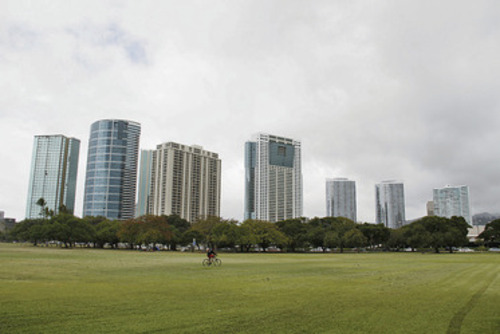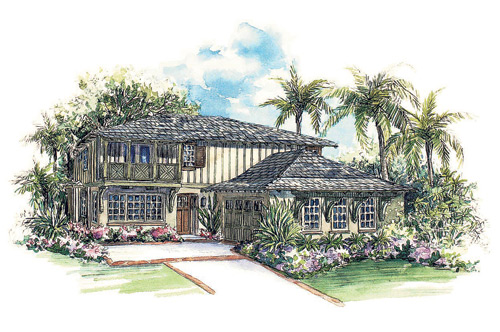Poised for a comeback

Development projects are being proposed for the urban core, including the Ala Moana area, shown here.

Developer Haseko Homes began sales in July of a new model in its Koa Lifestyle Series of homes with golf course views at Hoakalei Resort in Ewa Beach. This model with 2,612 square feet of living space is priced in the high $700,000s.


Local economists and real estate brokers like to say Oahu’s housing market cycle generally moves in the shape of a staircase: up, then across; up, then across. This year so far, a concensus appears to be building that the cycle is moving back toward, or into, the "up" phase.
During the first six months of this year, the median price of single-family homes was up 8.7 percent to $619,750 from $570,000 in the same period last year. That’s the biggest rise since 2005. And if forecasts calling for continued gains are correct, the median home price will set a new record next year.
Hawaii’s biggest residential real estate market has been in the "across" phase — actually a modest decline — slipping 11 percent over four years after the median home price peaked in 2007 at $643,500.
It will be hard for the market to make a big enough gain this year to overcome the 2008-2011 decline, but if the present median price is sustained through December, the market would end the year about 4 percent shy of the peak.
The University of Hawaii Economic Research Organization forecast in May that Oahu’s median home price will reach $649,000 next year, breaking the old record, and then keep rising to $700,000 in 2014.
Local economist Paul Brewbaker of TZ Economics said low inventory, a dearth of new home construction, rock-bottom interest rates and an expanding economy have created a recipe for price appreciation.
Don't miss out on what's happening!
Stay in touch with breaking news, as it happens, conveniently in your email inbox. It's FREE!
"We’re getting closer and closer to that moment when eventually home prices will break upward as they always have on Oahu in real estate cycles since the 1960s," he said.
One of the main factors putting upward pressure on prices is supply. The inventory of existing single-family homes and condominiums listed for sale at the end of June was 3,023, compared with 3,486 in the same month last year.
Meanwhile, homebuilders aren’t particularly busy, which means there isn’t a lot of new construction available for homebuyers.
Ricky Cassiday, a local housing market analyst, said the big developers have yet to ramp up production after dramatically scaling back when the economic recession and real estate downturn hit several years ago.
There has been somewhat of a high-rise condominium boomlet forming, with three planned towers getting ready to begin sales or already selling units.
One of the towers is Waihonua, a 340-unit luxury condo that launched sales in December and is slated to break ground later this year on a site between existing Hawaiki and Ko‘olani towers in Kakaako.
The other two are a 210-unit tower called One Ala Moana on top of the Nordstrom parking garage at Ala Moana Center and a 400-unit tower called Symphony just Ewa of Blaisdell Center.
At least four other towers from Kakaako to Waikiki are in less advanced planning stages and could add to the mix. However, building a high-rise takes about two years, so delivery of any new condo tower units won’t happen before 2014.
Other long-term housing developments include 11,750 single-family homes and townhouses at Ho‘opili in Ewa, and another 5,000 homes at Koa Ridge in Central Oahu. But those two master-planned communities still need county zoning approvals and are a few years away from delivering homes if approvals go smoothly.
Brewbaker said that last year was incredibly dismal for housing development — so dismal that there were only two other years in the past 70 years with fewer new homes authorized by building permit on Oahu: 1942 and 1943, during World War II.
Major subdivisions adding new homes on Oahu include Mehana in Kapolei, Villages of Kapolei, Kahiwelo at Makakilo, Sea Country in Maili, Ewa by Gentry in Ewa Beach and Ka Makana at Hoakalei in Ewa Beach.
According to Cassiday, developers sold 1,584 homes statewide last year — the lowest total in more than 30 years, during which annual volume has ranged from a low of 2,063 in 2010 to a high of 5,857 in 1993.
Demand for previously owned homes also hasn’t been strong. Last year the number of sales was flat at about 7,000. That followed a 15 percent gain in 2010 influenced by a federal tax credit stimulus program that aimed to prop up housing markets. This year through June, sales of existing homes are up 0.4 percent for single-family homes and are down 3.3 percent for condos.



